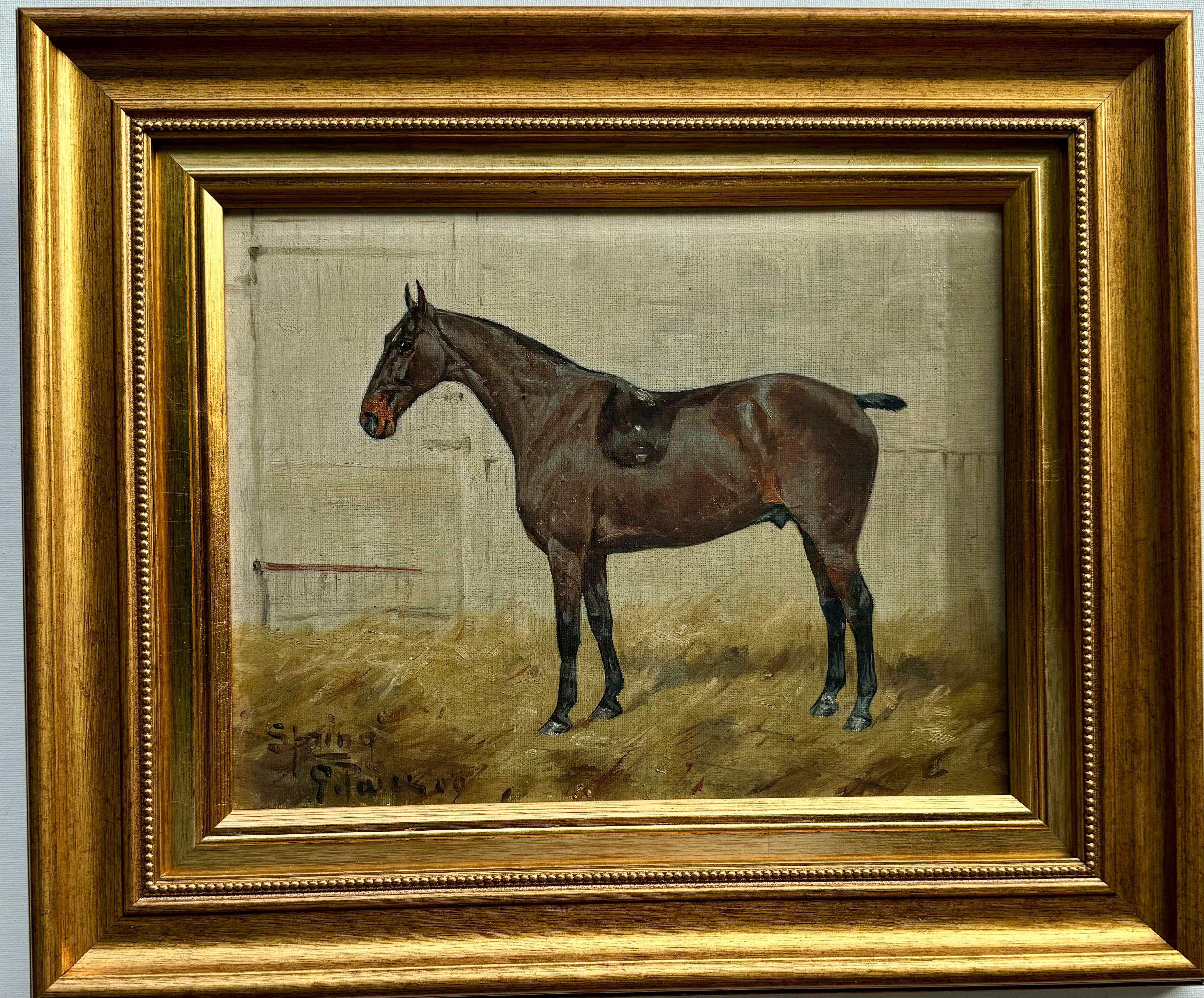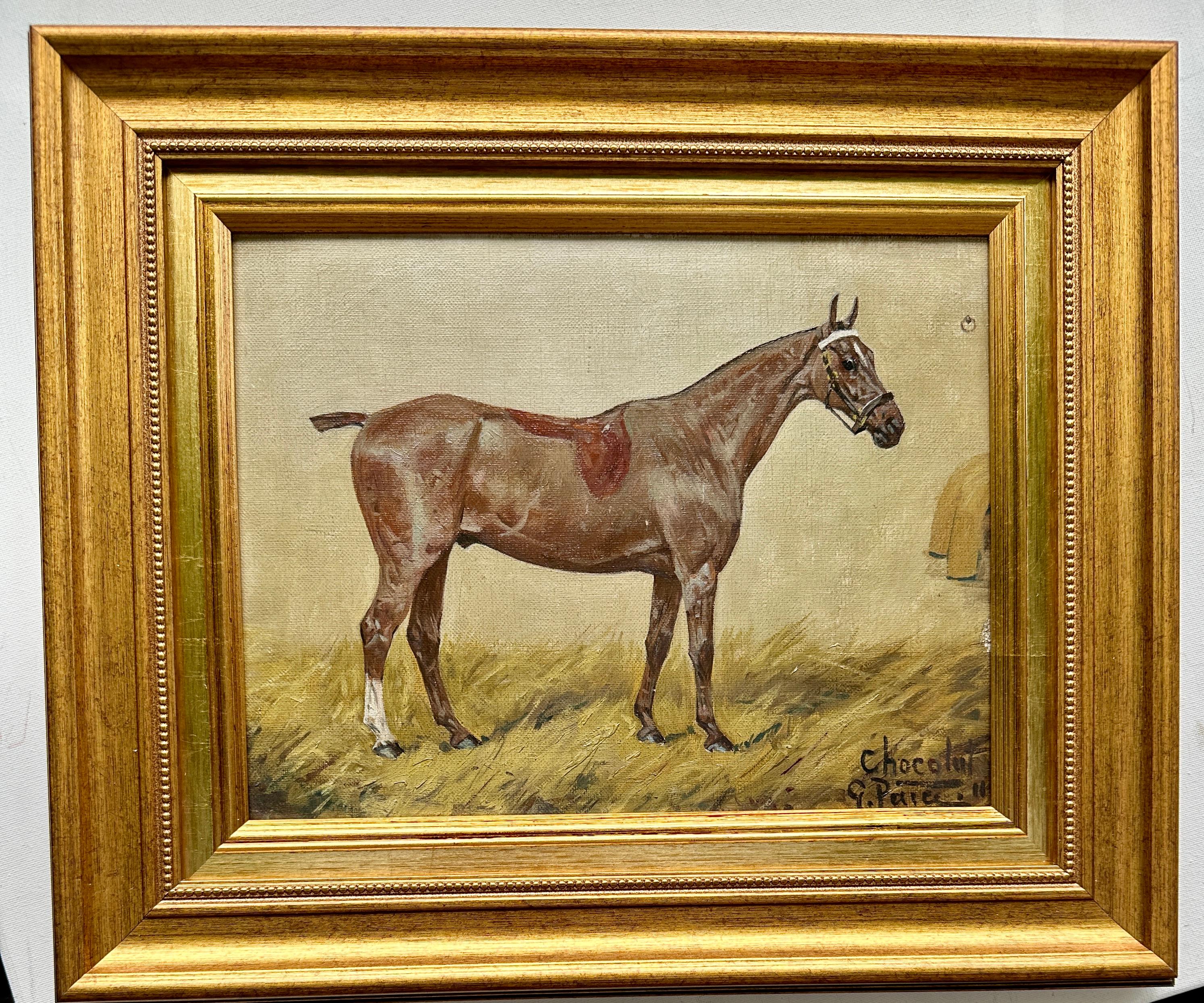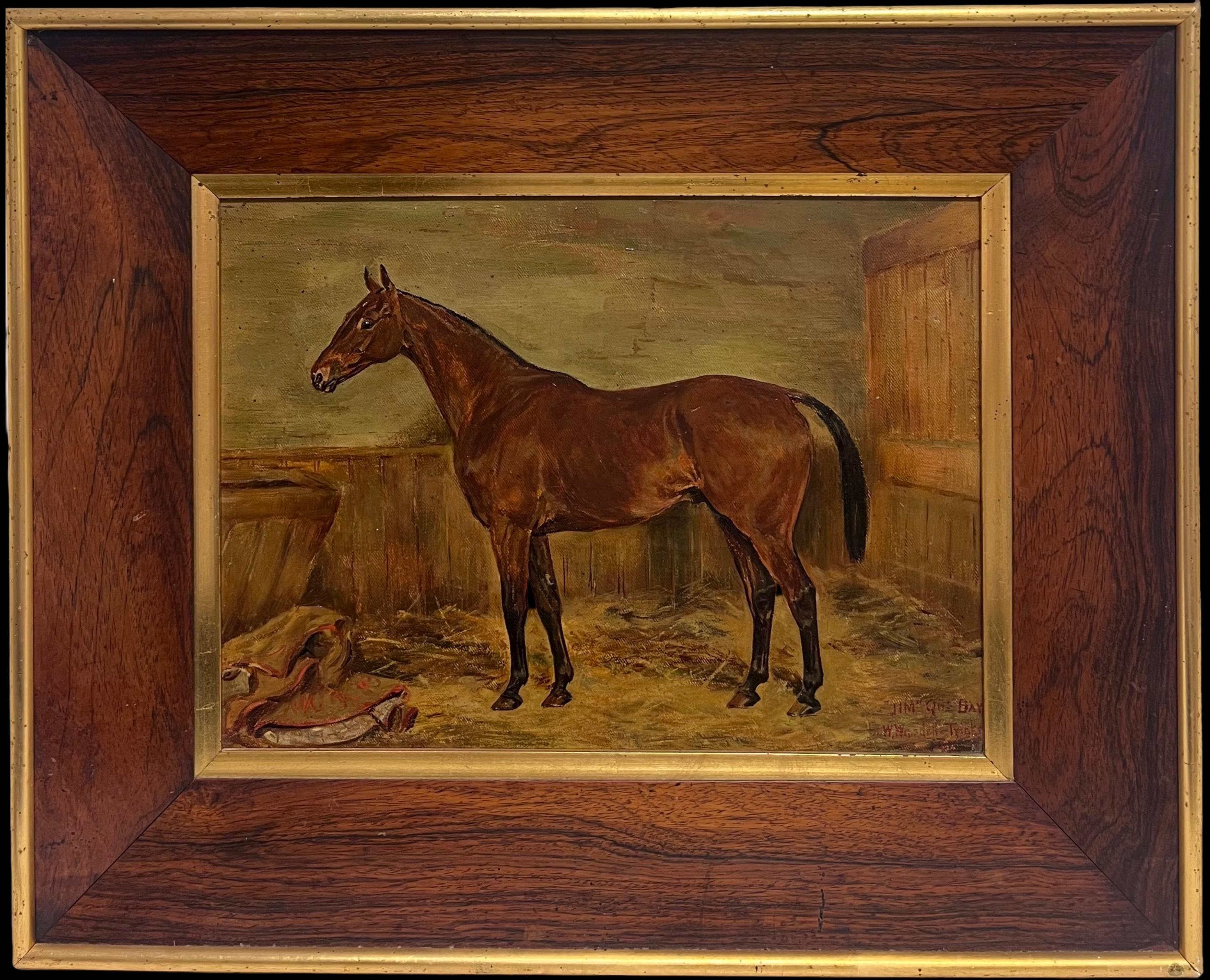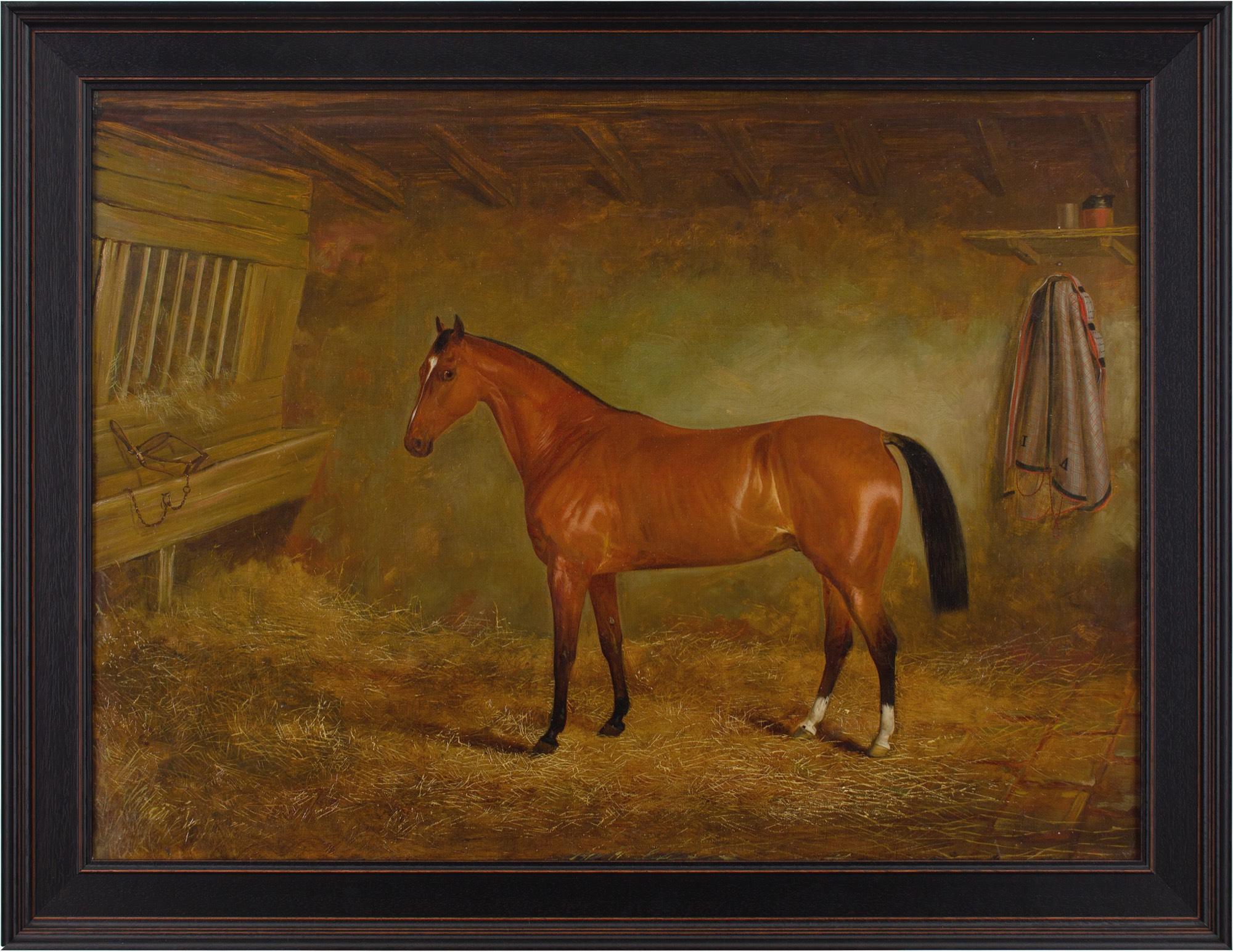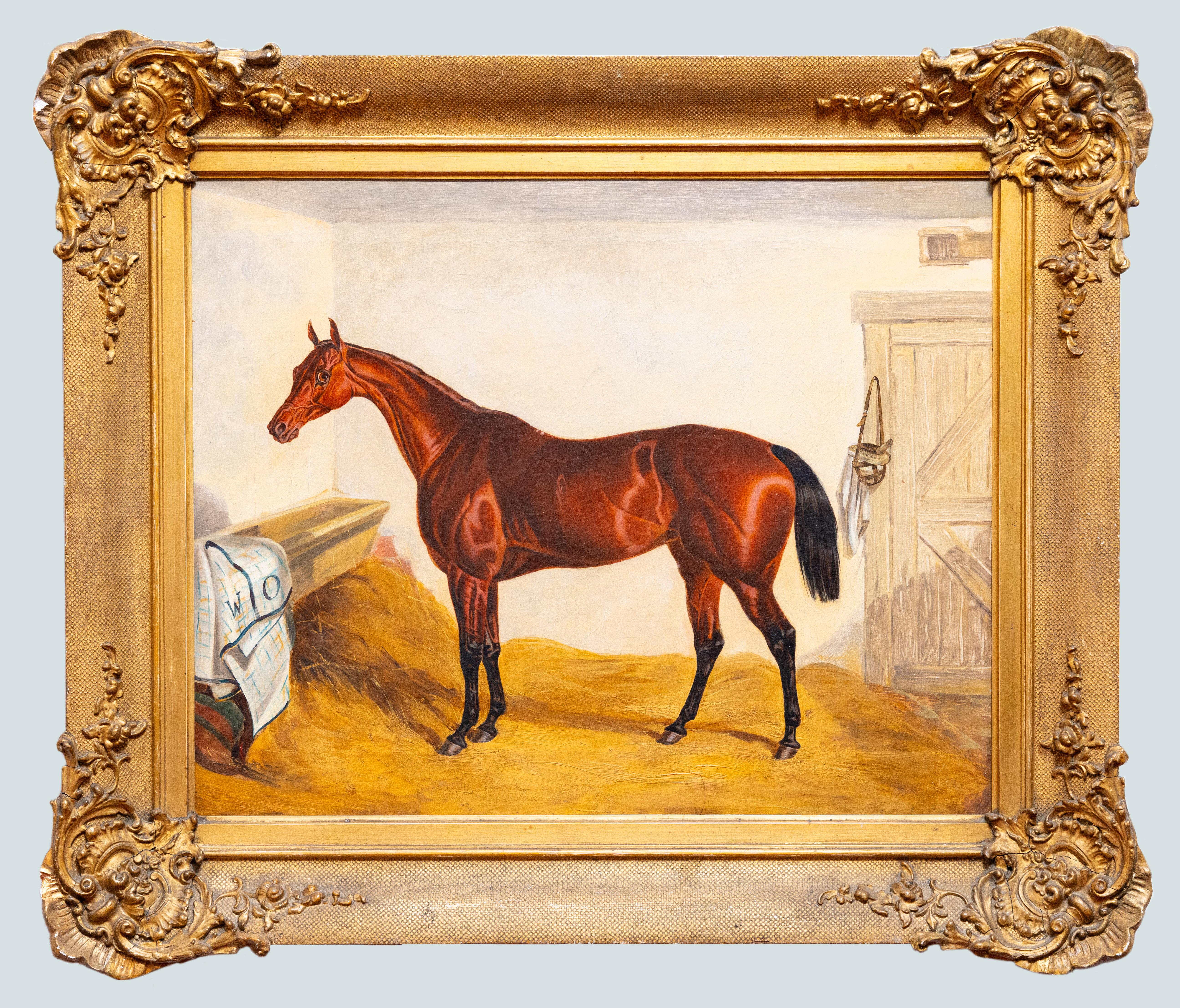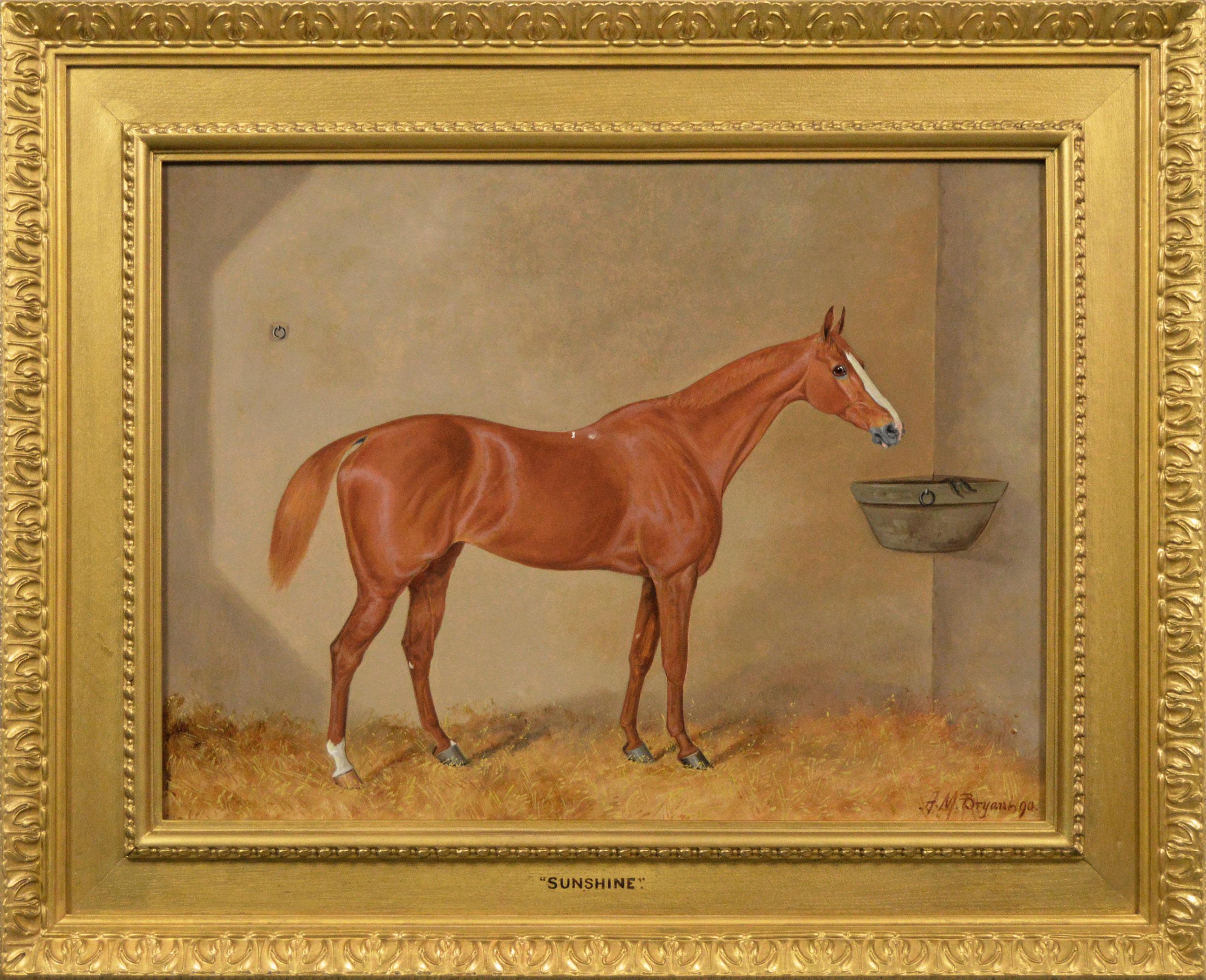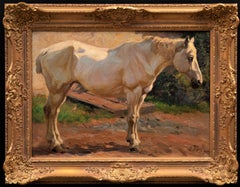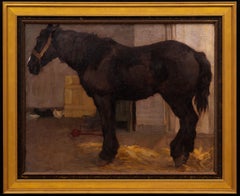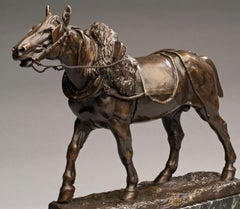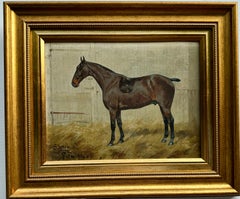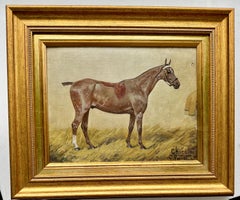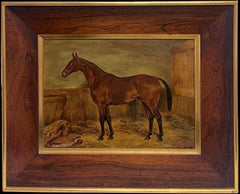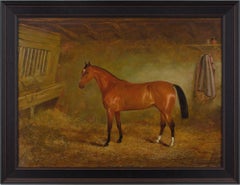Items Similar to Champion Thoroughbred Racehorse "Sysonby" (1902-1906) Edward Herbert Miner
Video Loading
Want more images or videos?
Request additional images or videos from the seller
1 of 17
Edward Herbert MinerChampion Thoroughbred Racehorse "Sysonby" (1902-1906) Edward Herbert Miner1905
1905
$14,240
$17,80020% Off
£10,746.54
£13,433.1720% Off
€12,303.16
€15,378.9520% Off
CA$20,083.12
CA$25,103.9020% Off
A$22,048.76
A$27,560.9520% Off
CHF 11,502.89
CHF 14,378.6120% Off
MX$266,820.72
MX$333,525.9020% Off
NOK 144,170.83
NOK 180,213.5320% Off
SEK 135,846.82
SEK 169,808.5320% Off
DKK 91,839.80
DKK 114,799.7520% Off
About the Item
"Sysonby"
Edward Herbert Miner (American, 1882-1941)
Depicting the champion thoroughbred horse Sysonby (1902-1906)
Oil on canvas, signed "E H Miner 1905"
24 x 32 inches (31 1/4 x 39 w/original frame)
Purchased 10/28/04 from The Collection of Mr. & Mrs. Walter M Jeffords, a prominent Philadelphia lawyer and racehorse owner, at Sotheby's NY, 2004
This is the only portrait located of this most historic and most important thoroughbred racers.
Sysonby (1902–1906) was an American Thoroughbred racehorse. He won every start easily, except one, at distances from one mile to two and a quarter miles. His superiority as a two and three-year-old was unchallenged during his short career of 15 race starts. Sysonby was regarded by many experts as the best horse to have raced in the United States between the Civil War and World War I. His sole loss in 15 starts came after he was doped by his groom as a bribe; even then, it took another member of the Hall of Fame, Artful, to beat him.
Foaled in Kentucky, Sysonby was a bay son of the 1885 Epsom Derby winner, Melton, out of the English mare Optime by Orme (by the undefeated Ormonde). The mating of Melton and Optime was arranged by Marcus Daly, who was involved with the Anaconda Copper Mine. Daly died before Optime, stabled in England, foaled. His stock, including the still pregnant Optime, was brought to New York to be auctioned. James R. Keene purchased Optime for $6,600, sending her to his Castleton Stud in Kentucky, which he rarely visited.
Apparently Optime's foal, observed in his paddock, was anything but inspiring. Considered unattractive and small, as well as slow, young Sysonby was to be sent back to England for sale. But Keene's trainer, the well-regarded James G. Rowe, Sr., had seen Sysonby in action during some early trials. When it was time for the yearlings to be sent away, Rowe, a leading trainer who had once been a leading jockey (guiding Harry Bassett to his Saratoga Cup win amongst many other successes), covered Sysonby in blankets, convincing Keene he was too ill to make the long ocean journey.
In the care of Rowe, Sysonby won everything Rowe entered him in by sizable margins, with the exception of the Futurity Stakes (USA), where he came in an unaccountable third, beaten by the filly Tradition and the filly Artful. Artful ranked 94th in the top 100 U.S. Thoroughbred champions of the 20th century by Blood-Horse magazine). Rowe saw Sysonby's groom exhibiting a large sum of money, and the groom admitted he'd been bribed to drug Sysonby before the race.
If not drugged, nothing beat Sysonby. The turf writer Neil Newman ranked Sysonby as one of the three best colts he'd ever seen. The other two were Colin (also trained by Rowe) and Man o' War.
Sysonby was the top money earner of 1905. Average winning margin was 4 ¼ lengths. Was ahead at every point of every race, except at the quarter call in the Brighton Junior Stakes, and in the stretch of the Futurity.
Sysonby was inducted into the National Museum of Racing and Hall of Fame in Saratoga Springs, New York, in 1956. In the list of the top 100 U.S. Thoroughbred champions of the 20th Century by Blood-Horse magazine, he ranks 30th.
Eighteen years after Sysonby's death, a December 11, 1924 Daily Racing Form article looking back on his racing career, called Sysonby "One of Greatest Race Horses in History of the American Turf". James Rowe, Sr. was also inducted posthumously into the Hall of Fame as a trainer.
Provenance: Walter Morrison Jeffords Sr. (August 8, 1883 – September 28, 1960) was a successful Investment banker and owner/breeder of Thoroughbred racehorses who, in partnership with his wife's uncle, Samuel Riddle, purchased and operated Faraway Farm near Lexington Kentucky where they stood Man o' War. Jeffords is one of only five people to be named an Exemplar of Racing by the National Museum of Racing and Hall of Fame.
His former estate is now Ridley Creek State Park.
- Creator:Edward Herbert Miner (1882 - 1941)
- Creation Year:1905
- Dimensions:Height: 31.25 in (79.38 cm)Width: 39 in (99.06 cm)
- Medium:
- Period:
- Condition:The painting is in very good condition and is housed in its original frame.
- Gallery Location:SANTA FE, NM
- Reference Number:1stDibs: LU1408216278832
About the Seller
5.0
Gold Seller
Premium sellers maintaining a 4.3+ rating and 24-hour response times
Established in 1995
1stDibs seller since 2020
121 sales on 1stDibs
Typical response time: 2 hours
- ShippingRetrieving quote...Shipping from: Santa Fe, NM
- Return Policy
Authenticity Guarantee
In the unlikely event there’s an issue with an item’s authenticity, contact us within 1 year for a full refund. DetailsMoney-Back Guarantee
If your item is not as described, is damaged in transit, or does not arrive, contact us within 7 days for a full refund. Details24-Hour Cancellation
You have a 24-hour grace period in which to reconsider your purchase, with no questions asked.Vetted Professional Sellers
Our world-class sellers must adhere to strict standards for service and quality, maintaining the integrity of our listings.Price-Match Guarantee
If you find that a seller listed the same item for a lower price elsewhere, we’ll match it.Trusted Global Delivery
Our best-in-class carrier network provides specialized shipping options worldwide, including custom delivery.More From This Seller
View AllAntique Horse Painting "Standing Grey Horse, Facing Right" Georg Wolf dated 1907
Located in SANTA FE, NM
Antique Horse Painting
“Standing Grey Horse, Facing Right”
Georg Wolf (Germany 1882-1962)
Oil on canvas
Signed and dated 1907 lower right
27 x 19 (35 x 27 frame) inches
With it's bobbed tail cut short so it doesn't become tangled, it's apparent that this fine specimen was a draught horse...
Category
Early 20th Century Post-Impressionist Animal Paintings
Materials
Canvas, Oil
Antique Horse Bronze Trotting Stallion Isidore Jules Bonheur (France, 1827-1901)
By Isidore Jules Bonheur
Located in SANTA FE, NM
Antique Horse Bronze
Portrait of a Trotting Stallion
Isidore Jules Bonheur (France, 1827-1901)
Cast bronze mounted on a rectangular plinth with dark brown patina,
Signed: I. BONHEUR
17 x 11 3/4
A brilliant exploration of a stallion in full trot. The patina is a deep, warm walnut brown with honey-colored tones.
Isidore Bonheur was best known and the most distinguished of the 19th century French animalier sculptors. Isidore, the younger brother of Rosa Bonheur and older brother of Auguste, began his studies of painting initially with his father, who was friends with Francisco Goya. By 1848 he debuted at the Paris Salon having discontinued animal and landscape painting to concentrate on creating sculptures and in 1849, Bonheur enrolled at the Ecole des Beaux Arts. He won medals at the Paris Salon in 1859 and did so again in 1865 and in 1869. After entering the Exposition Universelle 1855, he won the Gold Medal in 1889. In the 1870s exhibited in the London at the Royal Academy of Arts where he earned great prestige and won the coveted Medaille d’Or. After winning numerous other medals and prizes, Bonheur was awarded the Legion d' Honneur in 1895 and he was Knighted in Portugal, Spain and France. Bonheur continued exhibiting at the Paris Salon until 1899.
Many of his bronzes were fabricated at the foundry owned by Hippolyte Peyrol, Bonheur's brother-in-law by marriage to Isidore’s youngest sister Juliette Bonheur. The Peyrol casts for both Rosa and Isidore are exceptionally well executed which suggests a strong working relationship between the founder and sculptor. There is little doubt that Isidore Bonheur was an acute observer of nature; his animals were not anthropomorphized but modelled to catch movement or posture characteristics of the particular species he was sculpting. He achieved this most successfully with his sculptures of horses which are usually depicted as relaxed rather than spirited. These figures are among his most renowned works and his equestrian models became very popular, particularly among the British aristocracy.
An acute observer of nature, his sculptures reflect his commitment to the Realist school - with precise detailing of the movements of animals in their natural habitats. Ultimately, His naturalistic studies of animals are now some of the most highly sought after works by any of the animalier. He was possibly inspired by his many visits to the Buffalo Bill Wild West Show...
Category
1870s Realist Figurative Sculptures
Materials
Bronze
"Very Large Draft Horse Standing in a Barn" Georg Wolf (German, 1882-1962)
Located in SANTA FE, NM
“A Very Large Draft Standing Horse in the Stable”
Georg Wolf (Alsace/Germany 1882-1962)
Oil on canvas
39 1/2 x 21 1/2 (50 1/4 x 42 1/4 frame) inches
Estate stamp and inventory No. 17...
Category
Early 20th Century Post-Impressionist Animal Paintings
Materials
Canvas, Oil
$13,040 Sale Price
20% Off
Antique Bronze Portrait Draft Horse by Isidore Jules Bonheur (France, 1827-1901)
By Isidore Jules Bonheur
Located in SANTA FE, NM
Antique Bronze Portrait of a Draft Horse
Isidore Jules Bonheur (France, 1827-1901)
Circa 1840s
Cast bronze mounted on a rectangular plinth atop a marble s...
Category
1870s Realist Figurative Sculptures
Materials
Bronze
“In June (Im Juni)” By Julius Paul Junghanns dated "1913"
Located in SANTA FE, NM
“In June (Im Juni)”
Julius Paul Junghanns (German, 1876-1958)
Oil on canvas
Signed and dated “1913,” titled on reverse
18 ½ x 23 1/4 (27 1/4 x 31...
Category
1910s Impressionist Animal Paintings
Materials
Canvas, Oil
$7,120 Sale Price
20% Off
“Young Farmer with Draft Horses and Favorite Dog” Paul Junghanns (1876-1958)
Located in SANTA FE, NM
“Young Farmer with Draft Horses and Favorite Dog”
Paul Junghanns (German, 1876-1958)
Oil on Canvas
Signed verso
41 1/2 x 33 1/2
Depicted here is one of Junghanns favorite subjects d...
Category
1920s Post-Impressionist Animal Paintings
Materials
Canvas, Oil
You May Also Like
Early 20th century English Antique portrait of a Polo Pony
By George Paice
Located in Woodbury, CT
This early 20th-century portrait of a Polo Pony by the esteemed English artist George Paice is an exquisite representation of equine artistry, showcasing Paice’s remarkable skill in ...
Category
1910s Victorian Figurative Paintings
Materials
Oil, Board
Early 20th century English Antique portrait of a Polo Pony
By George Paice
Located in Woodbury, CT
This early 20th-century portrait of a Polo Pony by the esteemed English artist George Paice is an exquisite representation of equine artistry, showcasing Paice’s remarkable skill in ...
Category
1910s Victorian Figurative Paintings
Materials
Oil, Board
Fine 1920s British Horse Oil Painting Sporting Art Equestrian Portrait in Stable
Located in Cirencester, Gloucestershire
"Jim"
by WILLIAM WASDELL TRICKETT (FL. 1921-1939)
signed oil on canvas, framed in wooden original frame
framed: 18 x 22 inches
canvas : 12 x 16 inches
Provenance: private collection...
Category
Early 20th Century English School Animal Paintings
Materials
Oil
19th-Century English School, Portrait Of A Bay Horse, Antique Oil Painting
Located in Cheltenham, GB
This charming mid-19th-century English school oil painting depicts a bay horse in a stable.
The British aristocracy has always had a passion for equestrian activities, and during th...
Category
Mid-19th Century Victorian Animal Paintings
Materials
Oil, Canvas
Bay race horse in a stable, William Osborne RHA, Irish Artist, 1823 - 1901
By William Osborne
Located in GB
This painting by William Osborne, an Irish artist from the 19th century, features a bay racehorse in a stable, captured in rich oil on canvas. The scene evokes a sense of realism and attention to detail, as Osborne was known for his vivid depictions of horses, particularly those involved in racing or in stables. The piece is signed with the artist’s initials, and still features the original frame.
William Osborne is today best remembered as the father of the artist Walter Osborne. But he was a significant artist in his own right. He specialised in painting animals especially his own terriers who were often depicted in his studio. Strickland wrote ''His pictures of dogs...
Category
Late 19th Century Animal Paintings
Materials
Canvas, Oil
19th Century horse portrait oil painting of a chestnut hunter
Located in Nr Broadway, Worcestershire
Alfred Moginie Bryant
British, (1855-1935)
Sunshine
Oil on canvas, signed & dated (18)90
Image size: 17.75 inches x 23.75 inches
Size including frame: 26.5 inches x 32.5 inches
A f...
Category
Late 19th Century Victorian Animal Paintings
Materials
Canvas, Oil
More Ways To Browse
Antique Miners
Herbert Oil
Racehorses Painting
Man O War
Racehorse Oil
Racehorse Oil Painting
Thoroughbred Paintings
Wild Horse Painting
English Oil Paintings Dogs
Horse Coach
Horse Painting Old
Hunting Dogs Paintings
Koi Fish Painting
Oil Painting Elephant
Painting Oil Earl
Shark Painting
Whale Paintings
Antique Oil Paintings Of Dogs
